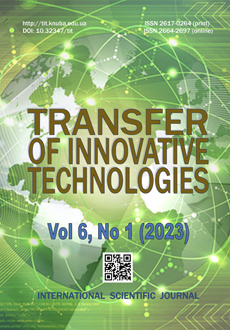Effectiveness of the using powder coating for protection of metal construction
DOI:
https://doi.org/10.32347/tit.2023.61.0104Keywords:
powder coating, talc, metakaolin, polymer,, corrosion resistance, peeling width, metal corrosion widthAbstract
Сurrent state of the Ukrainian economy causes to resolve a range of questions related to the improvement of production and increase in the ecological safety of products, including paint-and-varnishes materials, in combination with ensuring high operational properties of coatings based on them.
This questions can be solved by scaling up production using eco-friendly powder coating. The increase in popularity of powder coatings can be explained by their environmental adequacy and attractiveness from the perspective of the environmental protection as well as high effectiveness related to the possibility of obtaining high quality protective and decorative coatings with the high corrosion and chemical resistance as well as controllable physical and mechanical and dielectric characteristics during the one-layer application.
The analysis of research results shows that the effectiveness of use of metakaolin and talc as fillers in the powder coating increases in proportion to their content in the system. The optimal area of the powder coating with metakaolin and talc is limited to the additive in the range of 20 to 30 % and polyester resin in the range of 55 to 65 %. Using the mentioned range of fillers in the powder coating contributes to the decrease in the peeling width and metal corrosion width and places the coating into atmospheric corrosivity categories С3 and С4 according to ІSO 12944-2:2017 having a high (Н) lifespan from 15 to 25 years in accordance with DSTU ISO 12944-1
In this case, one of the most common methods of influence on properties of paint-and-varnishes coatings is to create polymer composites by combining polyester raw materials with inorganic fillers.
References
De Lange, P. A. (2004). History of Powder Coating P. De Lange. Paint & Coatings Industry Magazine Available, Vol.2, pp.16 – 24.
Richart, D.S. (1990). Powder Coating – Past, Present and Future: A Review of the State of the Art, Powder Coating, Vol.1, pp. 16 – 24.
Linak, E., Kishi, A., Yang, V. (2008) Thermosetting Powder Coatings, SRI consulting, 20.
Loar, D. (1993). Proc.20th Int. Waterborne, High Solids & Powder Coatings Symp., New Orleans, Feb., 536.
Al-Sherrawi M. (2018). Corrosion as a source of destruction in construction International Journal of Civil Engineering and Technology, 306-314.
Gots V., Lastivka O., Tomin O., Kovalchuk O. (2019) Influence of film-forming compo-nents on the corrosion resistance of powder coating Tech Publications Ltd, Switzerland 143-152.
Spyrou V. E. (2004). Powder Coatings - Chemistry and Technology. European Coatings Tech Files 3rd, 384.
Puig M., Gimeno J. (2018). Anticorrosive Properties Enhancement in Powder Coating Duplex Systems by Means of ZMP Anticorrosive Pigment Assessment by Electrochemical Techniques 1993-1999.
Golterova T, Obukhova (2018). Problem problems of economics of design and construction Scientific herald of construction 284-288.
Gots V. I., Lastivka O. V., Tomin O. O., Tymoshenko S. A. (2020) Fillers for modification of polyester powder coating. Materials Science and Engineering. – Innovative Technology in Architecture and Design 6.
Tager A. A., Askadsky А. А. (2007). Physical chemistry of polymers Scientific world, 573.
Downloads
Published
How to Cite
Issue
Section
License
Copyright (c) 2023 Oles Lastivka

This work is licensed under a Creative Commons Attribution 4.0 International License.
Our journal abides by the CREATIVE COMMONS copyright rights and permissions for open access journals.
Authors, who are published in this journal, agree to the following conditions:
1. The authors reserve the right to authorship of the work and pass the first publication right of this work to the journal under the terms of a Creative Commons Attribution License, which allows others to freely distribute the published research with the obligatory reference to the authors of the original work and the first publication of the work in this journal.
2. The authors have the right to conclude separate supplement agreements that relate to non-exclusive work distribution in the form in which it has been published by the journal (for example, to upload the work to the online storage of the journal or publish it as part of a monograph), provided that the reference to the first publication of the work in this journal is included.




